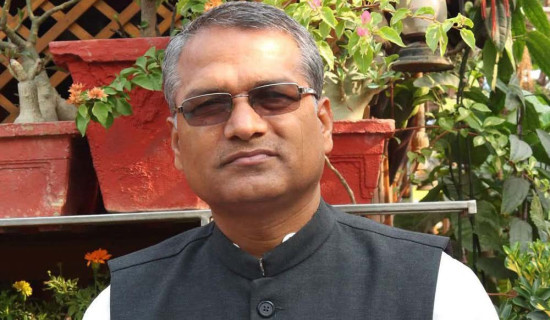- Saturday, 27 December 2025
The Mess Around Melamchi Project
When the Melamchi Water Supply Project was declared complete and the Melamchi water reached the households of the Kathmandu Valley in March 2021, the Valley denizens’ joy knew no bounds. The Valley people thought that their decades-long thirst would be quenched forever. But it was not to be. The project is not still fully complete. The water has been supplied to the Kathmandu Valley by constructing temporary headworks. When the flooding in the Melamchi River occurred in July 2021, the headworks and parts of the tunnel were damaged. Besides, temporary camps and Bailey bridges were also swept away. What is more, the flood also swept away eight workers – three Chinese, three Indians and two Nepalis. The damage was estimated at Rs. two billion. Whenever the monsoon season sets in, the problem of flooding occurs. The water supply to the Valley has now been halted for the last few days, citing problem triggered by the monsoon rain.
The Melamchi Water Supply Project is a national pride project. It was listed as such in the 2011/12 fiscal year’s budget. Its concept paper was prepared during the Panchayat period. But it got highlighted in the 1990s after the restoration of multi-party democracy in the country when Nepali Congress leader Krishna Prasad Bhattarai made it a point to bring water from the Melamchi River to the Kathmandu Valley. The project started in 1998 with the establishment of the Melamchi Water Supply Development Board under funding from the Asian Development Bank and Japanese International Aid Agency, supported by other loans, grants and domestic investments. The project was to be completed by 2006.
Hurdles
However, there were many hurdles the project had to face. In 2007, the contract with the UK contractor, Severn Trent, was cancelled as the contractor was found not to possess a strong international track record. In 2012, the contract with China Railway 15 Bureau Group Corporation, a Chinese contractor, was terminated over their unsatisfactory performance. Afterward, the contract was awarded to a new contractor, Cooperativa Muratori e Cementisti di Ravenna (CMC). The CMC was an Italian contractor. The contractor made significant progress in tunnel and water treatment plant construction.
In 2019, a dispute arose between the government and the CMC when the latter sought Rs. 1.61 billion in compensation for delays caused by the 2015 earthquake and the subsequent Indian blockade. But the government was agreeable to paying Rs. 350 million only. The CMC did not accept the government’s proposal and left the project. When the CMC left the project, it also left Rs. 1.53 billion in dues to local vendors. The local vendors demanded that the government pay them their dues. They threatened to obstruct the project works if they were not paid. Then, the government paid the dues. The government then brought Sino Hydro, a Chinese firm, on board to complete the remaining works on the project.
The project was also mired in corruption. In 2005, the then Prime Minister Sher Bahadur Deuba was accused of being involved in corruption by the Royal Corruption Control Commission formed by former King Gyandendra. However, the corruption case was dismissed after the Supreme Court ruled that the formation of the commission was unconstitutional. In 2006, Sweden withdrew from the project, suspecting that the project was mired in corruption. In 2019, the CMC alleged that 3 per cent commission was demanded in the payment of Rs. 300 million. This and the compensation issued led to the breaking of the contract with the CMC.
The Melamchi project has also claimed the lives of people. In July 2020, two employees had to lose their lives when the bulkhead gate burst open during the testing of the tunnel, triggering a flood. Likewise, eight people were swept away by the flood that occurred in June 2021. The Melamchi Water Supply Project is considered the best project when it comes to supplying drinking water to the Kathmandu Valley. At the same time, the project has turned out to be one of the mismanaged projects. Deadlines for the completion of the project were extended several times. It took over two decades for the project to supply water to the Valley when it should have done so by 2006. Still, the project has not been fully complete. The water supply has to be halted during the monsoons.
Erratic water supply
It is a pity that despite spending over Rs. fifty billion, including the cost incurred on land requisition, and taking over twenty years’ time, the water supply is still erratic. Ten people have also sacrificed their lives for the project. The project should have proved to be a model in the South Asian region. But it has turned out to be a much-delayed project, which does not give a positive message across the South Asian region. The government should learn lessons from this and suchlike projects such as the Sitka Irrigation Project.
The Melamchi Water Supply Development Board has made a decision to relocate the headworks to a new location. The board has also made preparations for making an additional tunnel of 400 to 500 metres along with a permanent intake and de-sander system. This will make it possible smoothen the water supply. The government has not been able to explore water sources in the Valley. Perhaps, the government is not willing to do so. If water sources scattered in the Valley had been identified and utilised, the water woes being faced by the Valley denizens could have been mitigated to a great extent. However, water tankers and bottled water factories are taking advantage of the situation at the expense of the Valley residents.
(Maharjan has been regularly writing on contemporary issues for this daily since 2000.)

















